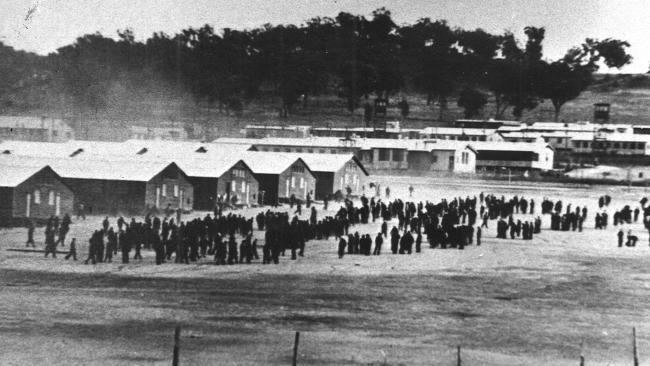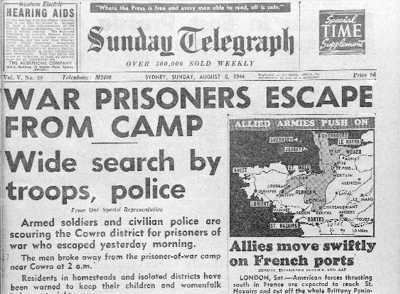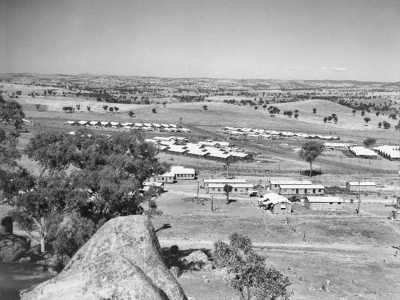Date 5 August 1944 | Result ~545 Japanese POWs escape Total number of deaths 235 | |
 | ||
Outcome ~545 Japanese POWs escape Similar Castle Hill convict rebellion, Battle of Alcatraz, Kengir uprising, Battle of Qala‑i‑Jangi, Badaber uprising | ||
Abc tv news world war one centenary the cowra breakout 5 8 2014
The Cowra breakout occurred on 5 August 1944, when at least 1,104 Japanese prisoners of war attempted to escape from a prisoner of war camp near Cowra, in New South Wales, Australia. It was the largest prison escape of World War II, as well as one of the bloodiest. During the ensuing manhunt, 4 Australian soldiers and 231 Japanese soldiers were killed. The remaining escapees were captured and imprisoned.
Contents
- Abc tv news world war one centenary the cowra breakout 5 8 2014
- The 70th cowra breakout commemorations
- POW camp
- Breakout
- Depictions in film and literature
- References

The 70th cowra breakout commemorations
POW camp

Cowra, a farming district, 314 km due west of Sydney, was the town nearest to No. 12 Prisoner of War Compound, a major POW camp, where 4,000 Axis military personnel and civilians were detained. The prisoners at Cowra also included 2,000 Italians, Koreans who had served in the Japanese military, and Indonesian civilians detained at the request of the Dutch East Indies government.

By August 1944, there were 2,223 Japanese POWs in Australia, including 544 merchant seamen. There were 14,720 Italian prisoners, who had been captured mostly in the North African Campaign, and 1,585 Germans, mostly naval or merchant seamen.

Although the POWs were treated in accordance with the 1929 Geneva Convention, relations between the Japanese POWs and the guards were poor, due largely to significant cultural differences. A riot by Japanese POWs at Featherston prisoner of war camp in New Zealand, in February 1943, led to security being tightened at Cowra. Eventually the camp authorities installed several Vickers and Lewis machine guns to augment the rifles carried by the members of the Australian Militia's 22nd Garrison Battalion, which was composed mostly of old or disabled veterans or young men considered physically unfit for frontline service.
Breakout
In the first week of August 1944, a tip-off from an informer at Cowra led authorities to plan a move of all Japanese POWs at Cowra, except officers and NCOs, to another camp at Hay, New South Wales, some 400 km to the west. The Japanese were notified of the move on 4 August.
In the words of historian Gavin Long, the following night:

The bugler, Hajime Toyoshima, had been Australia’s first Japanese prisoner of the war. Soon afterwards, prisoners set most of the buildings in the Japanese compound on fire.
Within minutes of the start of the breakout attempt, Privates Ben Hardy and Ralph Jones manned the No. 2 Vickers machine-gun and began firing into the first wave of escapees. They were soon overwhelmed by the sheer weight of those killed. Before dying, Private Jones managed to remove and hide the gun's bolt, rendering the gun useless. This prevented the prisoners from turning the machine gun against the guards.
Some 359 POWs escaped, while some others attempted or committed suicide, or were killed by their countrymen. Some of those who did escape also committed suicide to avoid recapture. All the survivors were recaptured within 10 days of their breakout.
During the escape and subsequent round-up of POWs, four Australian soldiers and 231 Japanese soldiers were killed and 108 prisoners were wounded. The leaders of the breakout ordered the escapees not to attack Australian civilians, and none were killed or injured.
The government conducted an official inquiry into the events. Its conclusions were read to the Australian House of Representatives by Curtin on 8 September 1944. Among the findings were:
Privates Hardy and Jones were posthumously awarded the George Cross as a result of their actions.
Australia continued to operate No. 12 Camp until the last Japanese and Italian prisoners were repatriated in 1947.
Cowra maintains a significant Japanese war cemetery. In addition, a commemorative Japanese garden was later built on Bellevue Hill to memorialize these events. The garden was designed by Ken Nakajima in the style of the Edo period.
